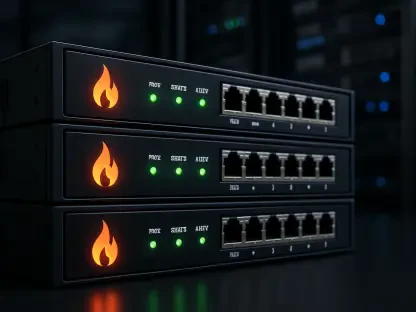In today’s digital age, data centers serve as the backbone of countless services and businesses, handling immense volumes of information every second. However, a persistent issue plaguing these facilities is downtime, a costly disruption often attributed to human errors. Historically, skilled personnel have manually managed these complex systems, making them prone to mistakes inherent in any human endeavor. As the demand for data centers grows alongside the rapid pace of technology, the pressure to maintain uninterrupted service has never been higher. This landscape sets the stage for a crucial conversation about the transition from manual operations to automation—a process that offers the promise of enhanced reliability, efficiency, and scalability. As experienced professionals retire and a new, less seasoned workforce takes their place, the need for automation becomes even more pressing, making it not just a strategic advantage but an operational necessity.
Understanding the Downtime Crisis
Downtime in data centers is an alarming issue with far-reaching implications. When these digital hubs go offline, even for a brief period, the consequences ripple across sectors, leading to significant financial losses and reputational damage. Businesses dependent on these centers for their online operations face the brunt of customer dissatisfaction, translating into lost revenue and market credibility. A staggering two-thirds of these disturbances are attributed to human error, whether due to misconfiguration, oversight, or other manual missteps. As data centers face growing complexity with more intricate systems, the potential for mistakes increases, making effective solutions imperative. The downtime problem isn’t just technical; it is deeply intertwined with business risks. Therefore, organizations are compelled to search for reliability-enhancing methods that can prevent catastrophic downtime scenarios, ultimately safeguarding their bottom lines and preserving consumer trust.
Automation: The Remedy for Human Error
Addressing human errors with effective automation has increasingly become the solution of choice for mitigating data center downtime. Automation offers unparalleled advantages in minimizing human involvement, allowing for tasks to be routinized and executed flawlessly by machines. This shift towards automated processes significantly reduces the potential for error, leading to lower operational costs and time expenditure. Automation serves as a robust framework for driving growth and performance in data centers, enabling them to handle more complex challenges with precision and predictability. By alleviating the reliance on human input for routine maintenance and operations, automation allows personnel to focus on strategic initiatives rather than troubleshooting repetitive issues. In doing so, data centers not only achieve operational stability but also foster an environment conducive to innovation and agility, further ensuring their readiness to meet future demands. Thus, automation emerges not merely as a technical advancement but as a strategic imperative for sustaining business continuity.
Exploring Nokia’s Innovative EDA Platform
Nokia’s event-driven automation (EDA) platform represents a significant leap forward in data center management, embodying the shift towards more efficient and reliable systems. This platform harnesses cutting-edge technology to bridge human intentions with machine execution, offering seamless integration of manual oversight with automated precision. By marrying these elements, the EDA platform significantly enhances the consistency and reliability of operations, reducing the need for human intervention in routine tasks. Through mechanisms like intent-based engines and digital twin technology, the platform can simulate and predict network scenarios, ensuring proactive measures can be taken before issues arise. Additionally, extensive telemetry across multi-vendor environments enhances its versatility, allowing for a tailored approach to various technological landscapes. With this level of sophisticated automation, data centers are better equipped to handle the complexities of modern network demands, paving the way for future advancements in data management and security.
Advantages of Automated Networks
Automation within network systems offers a plethora of advantages that fundamentally transform data center operations. By significantly increasing agility, automated networks can adapt rapidly to changing conditions and demands without the delays associated with manual adjustments. This responsiveness is crucial in an environment where uptime is synonymous with revenue and customer satisfaction. The consistency afforded by automated systems also means predictable outcomes, which is invaluable for maintaining trust with clients and users alike. The reduced risk of human error translates directly into fewer outages, resulting in a more reliable service offering. Furthermore, automation enhances security by minimizing the chance for configuration missteps that could leave networks vulnerable to threats. It ensures that data centers operate efficiently, maximizing resource utilization and enabling a level of innovation and experimentation that manual operations simply cannot support. Ultimately, automation represents a revolution in network management, driving efficiency and safety to new heights.
Intent-Based Networking as a Catalyst
Intent-based networking stands at the forefront of effective automation strategies, serving as a catalyst for aligning network operations with overarching business objectives. This approach simplifies network management by automating underlying tasks in accordance with desired outcomes and continuously adapting these tasks to the real-time environment. As a network’s intent becomes the guiding principle, operators no longer need to delve into the complexities of configuration and maintenance. Software intelligence interprets high-level directives, executing them across systems to ensure alignment with strategic goals. This adaptability means that as business demands evolve, network infrastructures do so in tandem, without additional overhead or delay. Intent-based networking offers a framework where seamless and adaptive processes flourish, essential for today’s fast-paced digital universe. By abstracting complexities and streamlining operations, this model drives efficiency, making it indispensable in the quest to optimize data center performance and ensure seamless business continuity.
Enhancing Observability and Flexibility
The Nokia EDA platform is at the forefront of technological innovation, particularly advanced in its observability and flexibility for data centers. By leveraging AI-driven natural language processing, it simplifies network configuration—a traditionally complex task—and makes management more intuitive for operators. This advancement facilitates real-time observability, allowing operators to monitor data flows and system behaviors easily, identifying and resolving potential issues before they escalate. The platform’s capability to integrate with existing tools and systems underscores its flexibility, ensuring that the transition to automated processes is smooth and minimally disruptive. Through this integration, operators can customize their networks to meet specific demands without relinquishing existing investments in technology. The AI-enabled insights provide an unprecedented level of control and precision, empowering engineers to make informed decisions based on comprehensive data analytics. This combination of observability and flexibility positions the platform as a crucial ally in transforming how data centers are managed and optimized.
Industry-Wide Trends Towards Automation
Across the industry, there is a growing recognition of the necessity for automation within data centers to keep pace with technological advancements. This shift reflects a consensus on the need for intelligent, scalable solutions that can evolve alongside emerging market demands. Companies are increasingly embracing automation as they seek to achieve consistency, reduce overhead, and enhance service reliability. The automation trend also answers the call for sustainability, allowing data centers to optimize energy use and reduce carbon footprints—critical considerations in today’s climate-conscious landscape. As industry leaders recognize automation’s potential, investments are directed toward developing smarter, more integrated systems that promise not only to maintain existing standards but to elevate them. This industry-wide embrace of automation signals a transition from traditional practices to forward-thinking strategies that prioritize innovation, adaptability, and continuous improvement. As such, automation emerges not merely as a technological choice but as an essential strategy for competitive advantage.
Balancing Technological and Human Factors
While the push toward greater automation in data centers remains crucial, it is equally important to strike a balance between technological progress and human involvement. As automation accelerates, it’s necessary to acknowledge the dynamic interaction between advanced systems and the workforce tasked with overseeing them. Introducing automated solutions requires operators to learn new skills, enabling them to effectively engage with these cutting-edge technologies. This shift underscores the need for equipping engineers with the proper tools and training to capitalize on automation fully. By prioritizing the upskilling of their teams, companies ensure that even those with less experience are empowered to manage and maintain sophisticated networks without jeopardizing safety or efficiency. Achieving this balance addresses the immediate operational demands and lays the groundwork for future technology adoption, nurturing a versatile workforce ready to keep pace with ongoing technological progress.
In summary, the elimination of data center downtime increasingly hinges on the strategic deployment of automation. Human errors continue to threaten operational reliability, making automated systems crucial allies in the battle against downtime. Nokia’s EDA platform exemplifies the benefits of integrating advanced tech to streamline and boost performance. The ongoing goal is to refine these systems and align them with market evolution. By investing in automation, data centers not only achieve operational excellence but also create environments ripe for innovation. This prepares them for future challenges and a landscape where downtime is dramatically reduced, enabling operations to function with remarkable efficiency and resilience.









